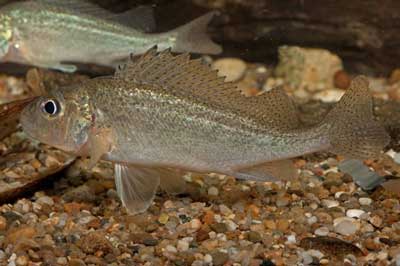Research
Section Ichthyology
Research projects of the Ichthyology Section

Traditioneller Fischfang am oberen Kongo bei Kisangani (Demokratische Republik Kongo) (Foto U. Schliewen)
Speciation
Organismic diversity is traditionally organized in populations, species and higher level systematic categories. We are interested in evolutionary patterns of processes that generate species level diversity, i.e. speciation. The main research focus is on the investigation of the effect of ancient and ongoing gene flow on the generation of species level diversity. between populations, incipient or established species Our main working hypotheses are that (1) species and species complexes of closely related species represent phylogenetic networks rather than trees, and that (2) ancient and ongoing introgression as well as homoploid hybrid speciation have significantly contributed to the evolution of species level diversity and adaptive novelty.
To infer and analyse patterns of morphological, ecological and genetic diversity we use fish “species flocks” confined to comparatively small and well circumscribed areas, e.g. small lakes and well defined stretches of rivers. Study systems include or have included in the past assemblages of closely related fish species, i.e. cichlids (Perciformes: Cichlidae) of Cameroonian, Ghanaen and Nicaraguan crater lakes, cichlid species assemblages in the recently evolved rapids of the Lower Congo River, telmatherinid (Atheriniformes: Telmatherinidae) species flocks in tectonic lakes on the Indonesian island of Sulawesi as well as lantern sharks (Squaliformes: Etmopteridae). Recently, the evolving diversity of Ponto-Caspian gobies (Perciformes: Gobiidae) which invaded the upper (Bavarian) Danube has been added as an evolutionary fish model system at ZSM.
Our methodological data acquisition and analysis tool-kit involves (1) traditional morphometric and anatomical measuring techniques, as well as geometric morphometrics based on digital images of photographed, X-rayed and cleared and stained specimens, (2) phylogenetic and population genetic analysis of DNA-sequence and DNA-fragment data including Next Generation Sequencing (NGS) approaches, and (3) the analysis of ecological data using standardized sampling methods, stomach content analysis as well as stable isotope analysis.
ZSM staff or associated people working on currently active speciation projects are: Julia Schwarzer & Juliane Wedekind (Congo project), Alexander Cerwenka & Carolin Schray (Goby project), Ulrich Schliewen.
Currently financed projects include
Patterns and processes of a multiple cichlid diversification along a unique geographical gradient in the Lower Congo River: Are species complexes fluid genomic networks? (DFG-project SCHL567/4 in cooperation with co-applicant Prof. B. Misof, ZFMK Bonn, with Prof. P. Alibert (Univ. Bourgogne, Dijon and Prof. Seraphin Ifuta (ISP Gombe, Kinshasa).
Evolutionary, population-genomic and ecological mechanisms of a simultaneous invasion of two closely related fish species in the upper Danube (DFG-project SCHL567/5 in cooperation with co-applicant Prof. J. Geist, TUM München)
The evolution megadiversity – evaluation of the role of mimicry egg spots of haplochromine cichlid fishes for research and educational display purposes. (Research grant from SeaLife Munich).
Recent publications include
Schwarzer J, Misof B & Schliewen UK (in press) Speciation within genomic networks: A case study based on Steatocranus cichlids of the lower Congo rapids. Journal of Evolutionary Biology, xxx-xxx
Schwarzer J, Misof B, Ifuta SN & Schliewen UK (2011) Time and origin of cichlid colonizsation of the lower Congo rapids. Plos One 6(7): e22380
Geiger M, McCrary J & Schliewen UK (2010) Not a simple case: a first comprehensive phylogenetic hypothesis for the Midas cichlid complex (Teleostei: Cichlidae: Amphilophus). Molecular Phylogenetics and Evolution 56(3):1011-24.
Straube N, Iglesias SP, Sellos DY, Kriwet J & Schliewen UK (2010) Molecular phylogeny and node time estimation of bioluminescent lantern sharks (Elasmobranchii: Etmopteridae) Molecular Phylogenetics and Evolution 56(3): 905-17.
Straube, N., Kriwet, J. & Schliewen, U. (2011) Cryptic diversity and species assignment of large lantern sharks of the Etmopterus spinax clade from the Southern Hemisphere (Squaliformes, Etmopteridae). Zoologica Scripta 40: 61-75
Diversity, Systematics and Taxonomy

Der Ammersee-Kaulbarsch, Gymnocephalus ambriaelacus, eine von ZSM-Mitarbeitern aus Bayern neu beschriebene Fischart (Foto A. Hartl)
Based in a traditional natural history collection, our research approach is based on the intimate knowledge of the diversity, systematics and taxonomy of the organismic groups we study. This expert knowledge is mainly derived from the discovery, description and analysis of targeted field collections of morphological as well as individualized genetic voucher specimens. Field trips are performed to subsaharan Africa and within Europe, often in close cooperation with national and international GOs and NGOs, as well as with research partners in Germany, Europe or Africa. Either during biodiversity assessments of protected areas or in the framework of evolutionary biology research grants specimens are collected, which often contain scientifically undescribed species. Based on these collections as well as on intensive comparisons of globally distributed museum specimens, species descriptions, revisions as well as faunistic studies are being prepared either as part of the evolutionary biology studies (see above), or as standalone systematic studies. Currently, systematic work at the ZSM centers around cichlids, but includes also studies on African non-cichlid freshwater fishes, marine gobies, as well as Bavarian freshwater fishes.
ZSM staff or associated people currently being active in fish systematics and taxonomy are: Julia Schwarzer, Juliane Wedekind, Andreas Dunz, Dirk Neumann.
Recent publications include
Schliewen UK (2011) Diversity and distribution of marine, euryhaline and amphidromous gobies from Western, Central and Southern Africa. In: The Biology of Gobies (eds.Patzner RA, VanTassell JL, Kovačić M & Kapoor BG.), Science Publishers Enfield, Jersey, Plymouth, 207-234
Straube N., Duhamel, G., Gasco N, Kriwet J & Schliewen UK (2011) Description of a new deep-sea Lantern Shark Etmopterus viator sp. nov. (Squaliformes: Etmopteridae) from the Southern Hemisphere. In: The Kerguelen Plateau: marine ecosystems and fisheries G Duhamel & D Welsford D eds.), Société Francaise d`Ichthyologie, pp 137-150
Neumann D, Stiassny MLJ & Schliewen UK (2011) Two new of Sarotherodon species (Pisces: Cichlidae)endemic to Lake Ejagham, Cameroon, west-central Africa, with comments on the Sarotherodon galilaeus species complex. Zootaxa 2765:1-20
Geiger M & Schliewen UK (2010) Gymnocephalus ambriaelacus, a new species of ruffe from Lake Ammersee, southern Germany (Teleostei, Perciformes, Percidae). Spixiana 33 (1) 119-137.
Dunz A & Schliewen UK (2010) Description of a Tilapia (Coptodon) species flock of Lake Ejagham (Cameroon) including a redescription of Tilapia deckerti Thys van den Audenaerde 1967. Spixiana 33(2): 251-280
Dunz A & Schliewen UK (2010) Description of a new species of “Tilapia” Smith, 1840 (Teleostei: Cichlidae) from Ghana. Zootaxa 2548: 1–21.


